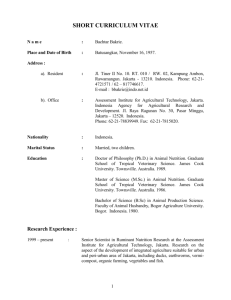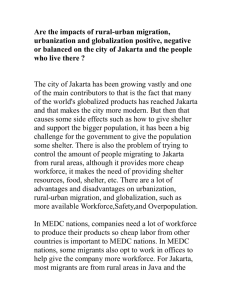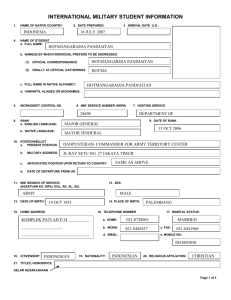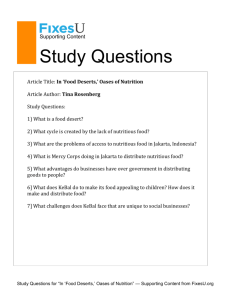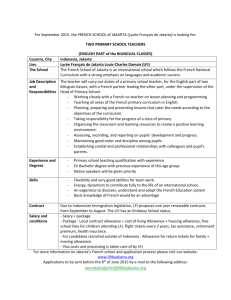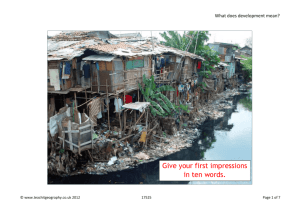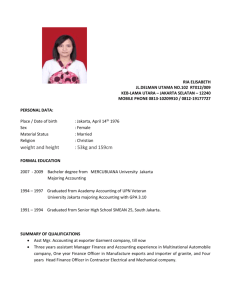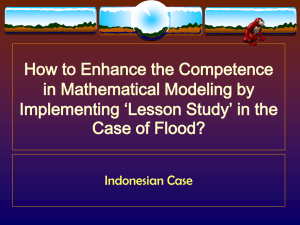Transport Social Equity
advertisement
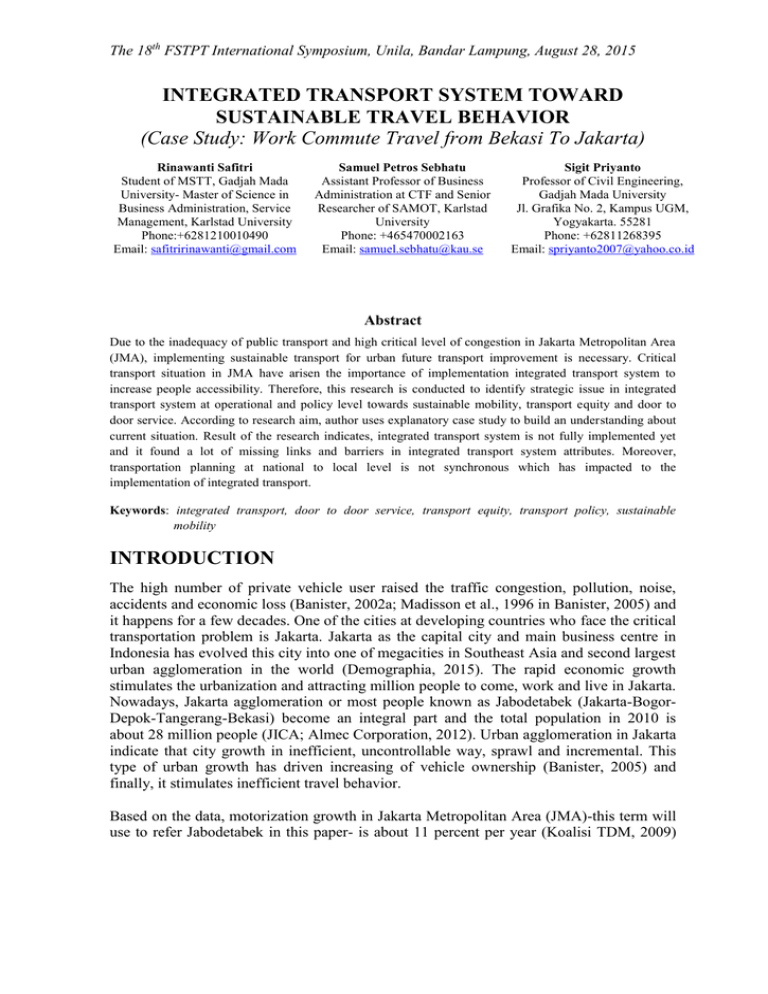
The 18th FSTPT International Symposium, Unila, Bandar Lampung, August 28, 2015 INTEGRATED TRANSPORT SYSTEM TOWARD SUSTAINABLE TRAVEL BEHAVIOR (Case Study: Work Commute Travel from Bekasi To Jakarta) Rinawanti Safitri Student of MSTT, Gadjah Mada University- Master of Science in Business Administration, Service Management, Karlstad University Phone:+6281210010490 Email: safitririnawanti@gmail.com Samuel Petros Sebhatu Assistant Professor of Business Administration at CTF and Senior Researcher of SAMOT, Karlstad University Phone: +465470002163 Email: samuel.sebhatu@kau.se Sigit Priyanto Professor of Civil Engineering, Gadjah Mada University Jl. Grafika No. 2, Kampus UGM, Yogyakarta. 55281 Phone: +62811268395 Email: spriyanto2007@yahoo.co.id Abstract Due to the inadequacy of public transport and high critical level of congestion in Jakarta Metropolitan Area (JMA), implementing sustainable transport for urban future transport improvement is necessary. Critical transport situation in JMA have arisen the importance of implementation integrated transport system to increase people accessibility. Therefore, this research is conducted to identify strategic issue in integrated transport system at operational and policy level towards sustainable mobility, transport equity and door to door service. According to research aim, author uses explanatory case study to build an understanding about current situation. Result of the research indicates, integrated transport system is not fully implemented yet and it found a lot of missing links and barriers in integrated transport system attributes. Moreover, transportation planning at national to local level is not synchronous which has impacted to the implementation of integrated transport. Keywords: integrated transport, door to door service, transport equity, transport policy, sustainable mobility INTRODUCTION The high number of private vehicle user raised the traffic congestion, pollution, noise, accidents and economic loss (Banister, 2002a; Madisson et al., 1996 in Banister, 2005) and it happens for a few decades. One of the cities at developing countries who face the critical transportation problem is Jakarta. Jakarta as the capital city and main business centre in Indonesia has evolved this city into one of megacities in Southeast Asia and second largest urban agglomeration in the world (Demographia, 2015). The rapid economic growth stimulates the urbanization and attracting million people to come, work and live in Jakarta. Nowadays, Jakarta agglomeration or most people known as Jabodetabek (Jakarta-BogorDepok-Tangerang-Bekasi) become an integral part and the total population in 2010 is about 28 million people (JICA; Almec Corporation, 2012). Urban agglomeration in Jakarta indicate that city growth in inefficient, uncontrollable way, sprawl and incremental. This type of urban growth has driven increasing of vehicle ownership (Banister, 2005) and finally, it stimulates inefficient travel behavior. Based on the data, motorization growth in Jakarta Metropolitan Area (JMA)-this term will use to refer Jabodetabek in this paper- is about 11 percent per year (Koalisi TDM, 2009) The 18th FSTPT International Symposium, Unila, Bandar Lampung, August 28, 2015 and it is increase from year to year. Every day, the traffic congestion becomes a part of daily live and it have affected economic loss 2.5 trillion rupiahs/day (JICA, 2002 in CMEA; JICA, 2012) and people quality of live. The existence of urban agglomeration is exacerbating the congestion condition in Jakarta because the neighboring cities around Jakarta are generated 7 million trips per day (JICA; Almec Corporation, 2012) and market share for public transport is small only about 23 to 30 percent (BPS, 2015). Current public transport service quality which connect people from outside Jakarta to inner city have insufficient service quality (JICA; Almec Corporation, 2012) and it makes public transport condition find unattractive for commuter. Generating effective transport policies that might change people travel behavior from car oriented to public transport oriented is by providing seamless mobility through public transport (Bruijns & Hartkamp, 2002). The main necessary for urban traveler is flexible mobility and the eminence of private vehicle is could provide it. Therefore, to make public transport attractive for user is by providing door-to-door service through integrated transport system. The idea of integrated transport system is not new for developed countries, it have implemented for years. Yet, it is successful to make people to choose public transport rather than private vehicle. Main concern of integrated transport system and door to door service is providing transport accessibility and seamless journey. Single transport modes, like what have developed now, do not meet the mobility needs for urban citizen but integrated transport system would be capable to deliver it. This service will allow people to have easy access from the moments their get out from the door to their final destination (Kanafani & Wang, 2010). Regarding to the issue, the research is conducted to give a strategic issue overview in integrated transport system at operational and policy level in Jakarta Metropolitan Area (JMA). THEORETICAL FRAMEWORK Integrated Transport System The main aim of implementing concept sustainability mobility to the current transport system is to encourage people to shift from motorized transport to public transport or/and non-motorized transport (Banister, 2008). Recently, many researches finding discussed about the importance of integrated transport system to encourage sustainable mobility (May & Roberts, 1995). The term of integration has close relationship to sustainability agenda and it strengthened by Hull’s arguments (2005) which implies the key drivers of policy integration is sustainability agenda and it is necessary to involve social, economic and environmental aspect comprehensively. May and Roberts (1995) perspective, using integrated approach will encourage much more advantage rather than single transport policy measures. Yet, integration could encourage a synergy of transport policy measures which is the key success to meet the strategic objective of sustainable transport agenda (ibid). Potter and Skinner (2000) define transport integration as a series of stage towards integration and sustainability and using incremental approach to achieve it. The practical form of integrated transport policy should give multiple choices for travel, facilitate the journey by walking or cycling, enhance public transport options, and using environmental The 18th FSTPT International Symposium, Unila, Bandar Lampung, August 28, 2015 friendly vehicle (if the only choice for travel is by car) (Potter & Skinner, 2000). Previous research which related to integrated transport system and door to door service has summarized several strategies to enhance integrated transport implementation. Please see the table below. Table 1 Integrated Transport System Strategy from Previous Research Researches Potter and Skinner (2000) May and Roberts (2006) Solecka (2013) in Novec and Solecka (2014) Novec (2014) and Solecka an integrated transport based on their scale or level Broader Perspectives of Integration model of integration specifically talk about the public transport system integration (Solecka, 2013 in Novec and Solecka, 2014) Emphasized on integration urban transport system which encourage attractive transport service chain Integrated Transport System Strategy Functional or modal integration, transport and planning integration, social integration, holistic integration Integration between policy instruments involving different modes, integration between policy instruments involving infrastructure provision, management, information, pricing, integration transport measures and land use planning, integration transport Infrastructure, organizational, economic integration, financial integration, information integration and spatial integration Public transport integration, public and private integration and policy integration Transport Social Equity Recently, issue about social equity in transport becomes an interest in transportation planning and policy (Solomon, 2003). The part of community who often experience of social exclusion in transport is unemployed, family who have kids, low incomes group, older people, disable, women and children (Solomon 2003; Hine & Mitchell, 2001, 2003; DETR, 2000; Social Exclusion Unit, 2003 in Hine & Grieco 2003). The key issue about the connection of social exclusion in transport was affordability, availability and accessibility (Solomon 2003; UN Habitat 2013). Mobility is provided an access to basic needs, services and activities, therefore each social groups should have an equal opportunity in urban mobility systems (UN Habitat, 2013). Then, to overcome the equity issue on mobility (Hine & Grieco, 2003) and fulfil the mobility needs of urban population (UN Habitat, 2013), facilitate travellers with public transport service (Hine & Grieco 2003; UN Habitat 2013) and non-motorized infrastructure would fill the gap in equity issue (UN Habitat, 2013). However, the solution to overcome transport equity issue is not merely about providing public transport, the most important thing is how to make public transport affordable for social exclusion group (ibid). Relationship of sustainable mobility, transport equity and integrated transport system The 18th FSTPT International Symposium, Unila, Bandar Lampung, August 28, 2015 Integrated transport system is one of solutions to encourage sustainable mobility (May & Roberts, 1995) and transport equity. Transport integration may happen at different level and require many transport measures (Nosal & Solecka, 2014). The form of transport integration may happen at practical level (Potter & Skinner, 2000) and broader perspective by looking the integration at policy level (May et al., 2006). The implementation of integrated transport system in operational or policy level would lead to door-to-door transport service. Both approaches have the same vision which is providing series of mobility solution. Provide people with integrated transport system as well as door to door service may lead to fulfillment mobility for all and it is suitable to concept of transport equity- all people should have the equal opportunity in mobility (UN Habitat, 2013). On other word, implement integrated transport system may generate sustainable mobility and simultaneously transport equity. METHODOLOGY Research Method Author uses qualitative research methodology and based on research case, the research method to conduct the research is using explanatory research case study. Explanatory case study is trying to build an understanding about current situation based on theory (Collis & Hussey, 2014). To understand integrated transport system in Jakarta Metropolitan Area (JMA) author formulate variable, indicator and parameter as boundaries to determine current situation. Variables, indicators and parameters are built from the literature review of journals, government documents and implementation of integrated transport system in several countries. In order to confirm theory to current situation, data collecting process involve field observation, in-depth interview, literature review and questionnaire. Advantages from using case study research is the researcher could get depth knowledge by utilize various methods (Collis & Hussey, 2014) and it looks the phenomena from different perspective to ensure get depth understanding from the case (Baxter & Jack, 2008). Data Collection Since the research methodology is qualitative, data collection might be combined using different type of techniques. Data collection techniques for this research will use observation and in-depth interview. Observation will be done by nonparticipant observer (Kuada, 2012) to observe field condition and situation in research location. To support primary data collection, this research is using secondary data from Ministry of Transportation and DKI Jakarta Government. Government document which related to the research focus is analyzed in order to find the implementation of integrated transport system at policy level. Data Analysis Data analysis combines content analysis and deductive analysis. Researcher analyzed previous journal, books, study, policy and planning document from several best practices country in order to arrange variables/attributes for implementing integrated transport system and door-to-door service. This analysis helps researcher to select variable or attributes which have high possibility to implement in Jakarta, Indonesia. Result from content analysis process is giving a hypothesis about the ideal strategy which translated into set of attributes or variables for implementation of door-to-door service towards The 18th FSTPT International Symposium, Unila, Bandar Lampung, August 28, 2015 integrated transport system. It variables or attributes is confirmed to empirical condition which are home-based work trip from Bekasi to Jakarta to understand the missing link of current commuting behavior from theoretical perspectives. RESULTS AND DISCUSSIONS Integrated Transport System Principle Implementation Identifying implementation of integrated transport system to the current condition is using 5 (five) attributes which are modal integration, information integration, pricing integration, and infrastructure integration. 1) Modal Integration Evaluating modal integration implementation should be started from how does the daily journey of commuter from Bekasi to Jakarta. Figure 1 Commuter Travel Behavior Figure 1 above is giving general information about the way of commuter travel from home to office, trunk service availability which connects people from Bekasi to Jakarta and feeder modes service availability. The identification of modal integration performance is determined based on a normal condition which there is no major disturbance of public transport service. It indicates that the barrier of modal integration come from trunk service and feeder service. For example, minibus taxis is successful to provide service until neighborhood area with high-frequency service but the level of uncertainty from minibus taxi is still high whereas to encourage people using public transport the uncertainty level should be removed. The uncertainty situation is occurred to current transport system such as long waiting time, unpredictable of service and information (Hine & Scott, 2000). In integrated transport concept, non-motorized facilities are important to encourage people using public transport and if wide-range modal integration is accomodated, it might increase people accessibility (GTZ, 2009). However, current condition indicates there are lack of non-motorizes facilities (bicycle and pedestrian access) in Jakarta and Bekasi. This condition is not appropriate with the integrated mission- to deliver sustainability- because it does not give traveller an opportunity to go by walking and cycling (Potter & Skinner, 2000) to reach the station or terminals. The low level of modal integration due to public transport network is not planned in a unified network. A unified network plan is important because it could generate the successfully of public transport in providing seamless multidestination travel (Dodson et al., 2011). The establishment of unified network and alleviating the uncertainty situation is in line with door-to-door principle which important The 18th FSTPT International Symposium, Unila, Bandar Lampung, August 28, 2015 to guarantee the travel continuity (MIMIC, 1999 in Nosal & Solecka, 2014) and current implementation of multimodal integration could not be delivered this necessity. 2) Information Integration The point of providing the traveler with public transport information is letting traveler arrange individual journey (Department for Transport, 2013). To identify the current degree of information integration to current public transport system, there are five indicators which are location information, types of information, timetables coordination, real-time information, fares and ticket product. Determination these indicators are according to the principal of door-to-door service which encourages traveler with precise, accessible and reliable various information of public transport mode (ibid). The evaluation of information integration is emphasized on formal public transport which is bus and commuter train service. For feeder service, the evaluation is not carried out since the characteristic of feeder service in Jakarta Metropolitan Area (JMA) under the conventional management system. Based on the identification of information integration indicator in commuter train and bus service, public transport information is not integrated yet and its only commuter train is providing the travel information for the passenger. Interzonal bus service does not have specific travel information even passenger could not get an access to time-schedule information. It would be difficult to establish information integration since both services are at different level. In summary, the information from public transport service in Jakarta Metropolitan Area (JMA) is still disconnected. The clear and quite accessible information only provide by commuter train service, whereas information is the important element for the public transport network (Dodson et al., 2011). Mees (2000; 2010) in Dodson et al., (2011) stated that the availability of interlinked information will lead to the highest level of public transport ridership since passenger could arrange their journey by combining the route segments and network. Each public transport operator has different scheme and even the bus service do not provide the user by clear information. The imbalance development between bus service and train service is one of barriers why information integration implementation far from ideal condition- passenger could get information from different network and different transport modes (Solecka, 2013 in Nosal & Solecka, 2014). Yet, the absence of timetable coordination indicates the organizational coordination among public transport operator is not established yet (ibid). 3) Pricing Integration The function of pricing integration is to make sure passenger get the best economical and financial condition when combine different means of transport in a journey (Solecka, 2013 in Nosal & Solecka, 2014). There are four elements of princing integration which are smart and integrated ticketing system, ticket unification, unified ticketing facilities and transport cost. Based on research finding, each public transport has different payment system but the existence of e-banking product from third party indirectly creates the unified ticketing system and facilities. Generally, current system is creating an inconvenience change system for public transport user (Mees, 2010 in Dodson et al., 2011). Meanwhile, to deliver door-to-door journey and The 18th FSTPT International Symposium, Unila, Bandar Lampung, August 28, 2015 offer seamless travel convenience, the affordable ticket is important to make people confident in using public transport (Department for Transport, 2013). Even though some of public transports (BRT system and Commuter Train) are subsidized by government, if combine two modes of transport from home to office and there is no free transfer between other modes, passenger spends much money for their daily journey. Logically, the free transfer cost system between different public transport operators may result to lost revenue but it could increase public transport attractiveness (Simpson, 2003). Finally, the number of people using public transport will increase (ibid). Overall, the progress of public transport pricing integration is on the right track. The development of smart ticketing system, ticketing facilities and ticket unification is already begun even though in fragmented manner. The important point from this case, organizational coordination between the public transport operator and private organization help to generate the pricing integration. To reach seamless travel and door-to-door service, all transport operators should maintain the coordination and establish receptive institutional environment (UN Habitat, 2013) to bring the pricing integration concept into the greater level. 4) Infrastructure Integration Concept of integrated transport system is emphasized on connectedness different means of transport. The importance point from infrastructure integration is encouraged network integration and as a result, it gives the convenience in transfer to different modes (Wesolowski, 2008 in Nosal & Solecka, 2014). There are four indicators that construct infrastructure integration, which are interchange facilities, park and ride facility, kiss and ride, bike parking and bike sharing facilities. Current condition indicates the interchange facilities between public transports are not well established yet. Public transport user is still facing barriers when did the interchange to other public transport modes. Current condition indicates the interchange only possible within same type public transport mode but feeder service is easy to find. Second indicator, park and ride facility near train station does not have appropriate space for car and not all interchange facilities provide parking space for car in Bekasi. Meanwhile, availability of parking space is main feature of park and ride facility (MIMIC, 1999). The third and fourth indicators are kiss and ride and bike parking and sharing. Both in station or terminal there is no specific place for dropping and picking off but it is possible to drop and pick off people in front of the station and terminal. The same goes to bike sharing and parking, there are none of bike share facility and appropriate bike parking facility. Overall, infrastructure integration in case study is not well implemented and it needs improvements since current infrastructure integration is not established in appropriate way and facilitated seamless transfer. Reflect to current infrastructure integration implementation, it is necessary to do many improvements in order to eliminate the barrier because transport infrastructure is important for setting up integrated transport system (Janic & Reggiani, 2001). Besides that, it should be considered to build connection between non-motorized transports since the principle of multimodal or intermodal journey should increase opportunity for all transport users (GTZ, 2009). Current interchange facility should be improved in order to accommodate access to public transport and switch between public transports (Terzis & Andrew, 2000). The 18th FSTPT International Symposium, Unila, Bandar Lampung, August 28, 2015 Synchronization of Transportation Master Plan to Enhance Integrated Transport System National government has been proposed “The Study on Integrated Transportation Master Plan for Jabodetabek (SITRAMP)” master plan to lead transportation planning toward integrated transport system in Jakarta Metropolitan Area (JMA). The existence of SITRAMP indicates government has high commitment to alleviate transportation problem in JMA. Ideally, transportation planning from city and municipality in Jakarta Metropolitan Area (JMA) should follow SITRAMP master plan. SITRAMP master plan also proposed public transportation master plan or known as Jabodetabek Public Transportation Policy Implementation Strategy (JAPTRAPIS). In JAPTRAPIS, the public transport strategy is explained in detail for transportation master plan until 2020 (JICA; Almec Corporation, 2012). In some part, proposed public transport development in SITRAMP and JAPTRAPIS indicated un-synchronous guidelines. The sign of unsynchronous transportation planning guideline affected the transportation policy in DKI Jakarta. Both DKI Jakarta Regional Planning (in transportation section) and DKI Jakarta Macro transportation planning refer the transportation planning from SITRAMP. Ideally, DKI Jakarta’s transportation planning should consider both master plan (SITRAMP and JAPTRAPIS). The unsynchronized master plan from top to bottom government could be caused by each transportation master plan is not launched orderly and transportation planning in bottom level should follow the policy direction from macro level. Public transportation priority development (JAPTRAPIS) should be released after Jabodetabek master plan (SITRAMP). Afterwards, local government in Jakarta Metropolitan Area should consider the SITRAMP and JAPTRAPIS documents to arrange transportation planning in local level. However, what happen in Jakarta Metropolitan Area (JMA) indicate the different sequence. Macro Transportation Planning (SITRAMP) is at right order but public transportation priority development (JAPTRAPIS) launched after DKI Jakarta transportation planning and regional planning. This might be the reason why in strategic and action plan of DKI Jakarta are not match with JAPTRAPIS’s proposes plans. As a result, DKI Jakarta Transportation Planning is not accommodating the priority public transport development from JAPTRAPIS. Jakarta Metropolitan Area (JMA) has segregated authority and every cities and municipalities under different administration area. Meanwhile, the successfulness of public transport network implementation depends on centralized coordination (Mees 2000; 2010 in Dodson et al., 2011). The autonomy regulation in Indonesia causes national government has lack of intervention power to the provincial or local government (see UU No. 32 Tahun 2004). Furthermore, the transportation planning master plan (SITRAMP) does not have legal power since it is not legalized by national government. In contrast, the role of central government is crucial to encourage public policy in local level (Jessop, 2002; Vigar et al., 2000 in Hull, 2005). CONCLUSIONS The 18th FSTPT International Symposium, Unila, Bandar Lampung, August 28, 2015 The explanation and discussion about the implementation integrated transport system indicate that there are a lot of missing links and barriers in each attributes. Ideally, the four attributes should be fully implemented in order to deliver the door-to-door service. Partially implemented integrated transport system would cause the commuter find a barrier when traveling from Bekasi to Jakarta and it might be the reason why the market share for public transport in Jakarta Metropolitan Area (JMA) is decreasing. Moreover, current public transport system is not giving user flexibility to do their daily travel since the choice is limited and every choice of transport modes has their own obstacle and deficiency. Currently, the fragmented public transport system has been affecting inefficient and unenvironmental friendly journey. Transportation planning from national government to local government is not synchronous and it related to sequence of transportation policy which is not developed orderly based on policy level. Moreover, Jakarta Metropolitan Area (JMA) is not under the integrated authority and each authority does not have clear coordination consensus to develop the urban transportation planning in JMA. Implementation of transportation policy in Jakarta is much more difficult due to multi level governance (Hull, 2003 in Hull, 2005) in JMA. REFERENCES Banister, D., 2005. Unsustainable Transport: City Transport in the New Century. New York: Routledge. Banister, D., 2008. The Sustainable Mobility Paradigm. Transport Policy, 15, pp.73-80. Baxter, P. & Jack, S., 2008. Qualitative Case Study Methodology: Study Design and Implementation for Novice Researchers. The Qualitative Report, 13(4), pp.544-59. BPS, 2015. Berita Resmi Statistik: Komuter DKI Jakarta 2014. BPS. Bruijns, R. & Hartkamp, F., 2002. Seamless Mobility: Cycling's Contribution to Sustainable Mobility. Association for Eurpean Transport. Collis, J. & Hussey, R., 2014. Business Research: A Practical Guide for Undergraduate and Postgraduate Students. 4th ed. London: Palgrave Macmillan Higher Education. Demographia, 2015. Demographia World Urban Areas: Built Up Urban Areas or World Agglomerations. Department for Transport, 2013. Door to Door : A Strategy for Improving Sustainable Transport Integration. London: Department for Transport. Dodson, J., Mees, P., Stone, J. & Burke, M., 2011. The Principles of Public Transport Network Planning: A Review of The Emerging Literature with Select Examples. Urban Research Program Publications. Brisbane: Urban Research Program Publications Griffith University. Elo, S. & Kyngas, H., 2007. The Qualitative Content Analysis Process. Journal of Advanced Nursing, 62(1), pp.107-15. GTZ, 2009. Cycling-Inclusive Policy Development: A Handbook. Utrech: GTZ. Hine, J. & Grieco, M., 2003. Sactters and Clusters in Time and Space: Implications for Delivering Integrated and Inclusive Transport. Transport Policy, 10, pp.299-306. Hine, J. & Scott, J., 2000. Seamless, Accessible Travel: Users Views of the Public Transport Journey and Interchange. Transport Policy, pp.217-26. The 18th FSTPT International Symposium, Unila, Bandar Lampung, August 28, 2015 Hull, A., 2005. Integrated Transport Planning in the UK: From Concept to Reality. Journal of Transport Geography, 13, pp.318-28. Janic, M. & Reggiani, A., 2001. Integrated Transport Systems in the European Union: An Overview of some recent developments. Transport Reviews: A Transnational Transdisciplinary Journal, pp.469-97. JICA; Almec Corporation, 2012. JABODETABEK Urban Transportation Policy Integration Project in the Republic of Indonesia. Final Report. Jakarta: Coordinating Ministry of Economic Affairs Republic of Indonesia Coordinating Ministry of Economic Affairs Republic of Indonesia; JICA; Almec Corporation. Kanafani, A. & Wang, R., 2010. Measuring Multimodal Transport Level of Service. Berkeley: University of California Transportation Center. Koalisi TDM, 2009. Koalisi TDM. [Online] Koalisi TDM Available at: http://www.kpbb.org/news/tdm-erp-factsheet-280111-screen.pdf [Accessed 8 March 2015]. Kuada, J., 2012. Research Methodology: A Project Guide for University Students. Frederiksberg: Samfunds Litteratur. May, A.D., Kelly, C. & Shepherd, S., 2006. The Principles of Integration in Urban Transport Strategies. Transport Policy, 13, pp.319-27. May, A.D. & Roberts, M., 1995. The Design of Integrated Transport Strategies. Transport Policy, 2(2), pp.97-105. MIMIC, 1999. Intermodality and Interchanges. European Commission. Nosal, K. & Solecka, K., 2014. Application of AHP for Multi-criteria Evaluation of Variants of the Integration of Urban Public Transport. Transportation Research Procedia, 3, pp.269-78. Penalosa, E., 2005. Sustainable Transport: A Sourcebook for Policy-makers in Developing Cities [Module 1a] The Role of Transport in Urban Development Policy. Eschborn: Deutsche Gesellschaft fur Technische Zusammenarbeit (GTZ) GmbH. Potter, S. & Skinner, M.J., 2000. On Transport Integration: A Contribution to Better Understanding. Futures, 32, pp.275-87. Schutt, R.K., 2011. Investigating the Social World: The Process and Practices of Research. California: SAGE Publications, Inc. Simpson, J.B., 2003. Urban Public Transport Today. London: Taylor & Francis e-Library. Solomon, J., 2003. What is Transport Social Exclusion? In A. Root, ed. Delivering Sustainable Transport: A Social Science Perspective. Pergamon. pp.151-56. Susilo, Y.O., Santosa, W., Joewono, T.B. & Parikesit, D., 2007. A Reflection of Motorization and Public Transport in Jakarta Metropolitan Area. IATSS Research, 31(1), pp.59-68. Terzis, G. & Andrew, L., 2000. GUIDE- Urban Interchanges- A Good Practice Guide. Surrey: European Commission Under The Transport RTD Programme of The 4th Framework Programme European Commission. UN Habitat, 2013. Planning and Design for Sustainable Urban Mobility: Global Report on Human Settlements 2013. Oxon: Routledge.
